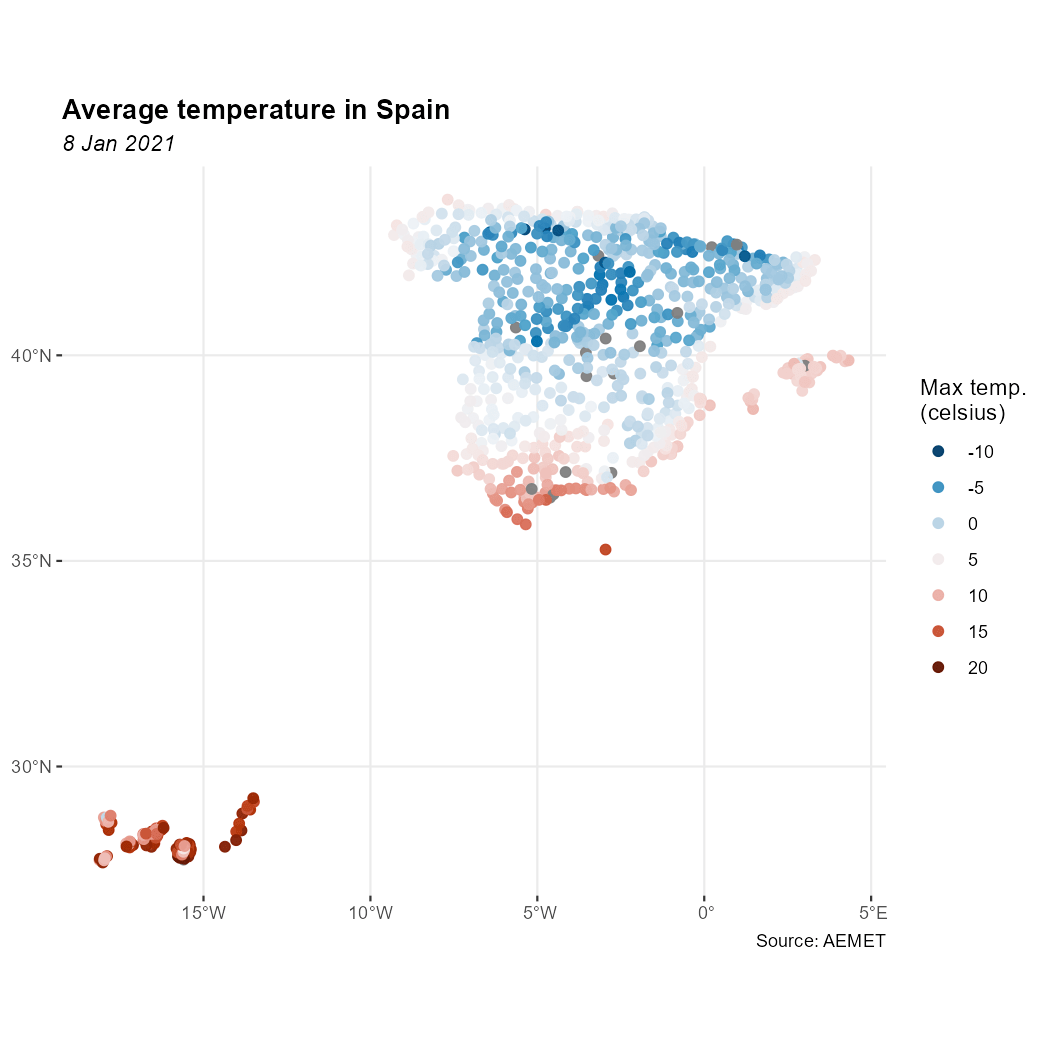Since the last release, this package has been integrated into rOpenSpain, a community of R enthusiasts whose ultimate goal is to create high-quality R packages for data mining public Spanish open sources.
From version 1.0.0 onward, we have introduced some improvements and (breaking) changes on the package, in order to provide a smoother interaction with the AEMET API service.
API Key
Get your API Key
To be able to download data from AEMET you will need a free API key which you can get at https://opendata.aemet.es/centrodedescargas/obtencionAPIKey
Once that you have your API Key, you can use any of the following methods:
a. Set API Key with aemet_api_key()
This is the recommended option. Just type:
aemet_api_key("YOUR_API_KEY", install = TRUE)Using install = TRUE ensures that the API key is stored
on your local computer and it would be reloaded every time you load the
library. From now on you can forget about API keys!
b. Use an environment variable
This is a temporary alternative. You can set your API key as an environment variable
Sys.setenv(AEMET_API_KEY = "YOUR_API_KEY")Note that this is only valid for the current session. You would need to re-run this command each time you restart your session.
c. Modify your .Renviron file
This stores your API key permanently on your machine. You can start
editing your .Renviron running this command:
usethis::edit_r_environ()Now you can add the following line to you .Renviron
file:
AEMET_API_KEY = YOUR_API_KEYNew features
tibble format
From v1.0.0 onward, climaemet
provides its results in tibble format.
Also, the functions try to guess the correct format of the fields
(i.e. something as a Date/Hour now is an hour, numbers are parsed as
double, etc.).
See how a tibble is displayed:
# See a tibble in action
aemet_last_obs("9434")
#> # A tibble: 13 × 25
#> idema lon fint prec alt vmax vv dv lat dmax ubi pres hr
#> <chr> <dbl> <dttm> <dbl> <dbl> <dbl> <dbl> <dbl> <dbl> <dbl> <chr> <dbl> <dbl>
#> 1 9434 -1.00 2025-12-16 04:00:00 0 249 2.6 1.5 82 41.7 75 ZARAGO… 977. 99
#> 2 9434 -1.00 2025-12-16 05:00:00 0 249 2.2 0.9 73 41.7 108 ZARAGO… 977. 100
#> 3 9434 -1.00 2025-12-16 06:00:00 0 249 2.2 1.2 88 41.7 80 ZARAGO… 978. 100
#> 4 9434 -1.00 2025-12-16 07:00:00 0 249 2.1 1.1 87 41.7 90 ZARAGO… 978. 100
#> 5 9434 -1.00 2025-12-16 08:00:00 0 249 5.8 1.8 75 41.7 343 ZARAGO… 979. 98
#> 6 9434 -1.00 2025-12-16 09:00:00 0 249 2.6 1.4 107 41.7 128 ZARAGO… 979. 99
#> 7 9434 -1.00 2025-12-16 10:00:00 0 249 5.5 3.8 138 41.7 140 ZARAGO… 980. 95
#> 8 9434 -1.00 2025-12-16 11:00:00 0 249 5.8 3.4 121 41.7 140 ZARAGO… 980. 94
#> 9 9434 -1.00 2025-12-16 12:00:00 0 249 4.1 1.7 112 41.7 130 ZARAGO… 980 92
#> 10 9434 -1.00 2025-12-16 13:00:00 0 249 2.4 1 330 41.7 98 ZARAGO… 980. 91
#> 11 9434 -1.00 2025-12-16 14:00:00 0 249 2.5 1.7 333 41.7 355 ZARAGO… 980. 88
#> 12 9434 -1.00 2025-12-16 15:00:00 0 249 2.7 2.1 308 41.7 303 ZARAGO… 981. 87
#> 13 9434 -1.00 2025-12-16 16:00:00 0 249 4.6 3.1 315 41.7 305 ZARAGO… 981. 89
#> # ℹ 12 more variables: stdvv <dbl>, ts <dbl>, pres_nmar <dbl>, tamin <dbl>, ta <dbl>,
#> # tamax <dbl>, tpr <dbl>, stddv <dbl>, inso <dbl>, tss5cm <dbl>, pacutp <dbl>, tss20cm <dbl>Note that when possible, data representing dates and numbers are converted to the right format.
Spatial objects: sf
Another major change in v1.0.0 is the ability of
return information on spatial sf format, using
return_sf = TRUE. The coordinate reference system (CRS)
used is EPSG 4326, that correspond to the World
Geodetic System (WGS) and return coordinates in
latitude/longitude (unprojected coordinates):
# You would need to install `sf` if not installed yet
# run install.packages("sf") for installation
library(ggplot2)
library(dplyr)
all_stations <- aemet_daily_clim(
start = "2021-01-08", end = "2021-01-08",
return_sf = TRUE
)
ggplot(all_stations) +
geom_sf(aes(colour = tmed), shape = 19, size = 2, alpha = 0.95) +
labs(
title = "Average temperature in Spain",
subtitle = "8 Jan 2021",
color = "Max temp.\n(celsius)",
caption = "Source: AEMET"
) +
scale_colour_gradientn(
colours = hcl.colors(10, "RdBu", rev = TRUE),
breaks = c(-10, -5, 0, 5, 10, 15, 20),
guide = "legend"
) +
theme_bw() +
theme(
panel.border = element_blank(),
plot.title = element_text(face = "bold"),
plot.subtitle = element_text(face = "italic")
)
Example: Temperature in Spain
Further enhancements
Other enhancements included on the v1.0.0:
- All the functions are now vectorized.
- New function
get_metadata_aemet(). - New function
ggclimat_walter_lieth(). This function is now the default forclimatogram_*functions. Old behavior can be reproduced with options
ggplot2 = FALSE. - Plot functions gains new parameters (
verboseand...). Now it is possible to pass colors to the plotting functions. - New example datasets:
climaemet::climaemet_9434_climatogram,climaemet::climaemet_9434_tempandclimaemet::climaemet_9434_wind.
